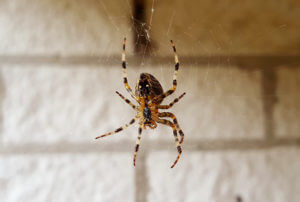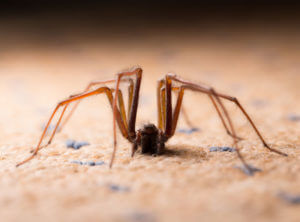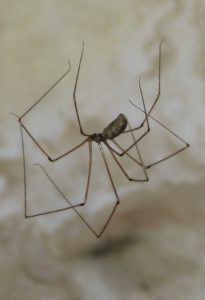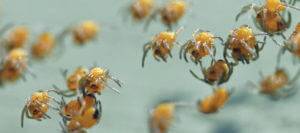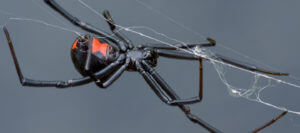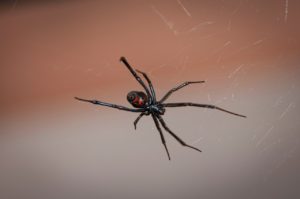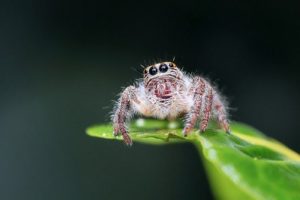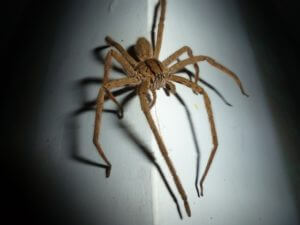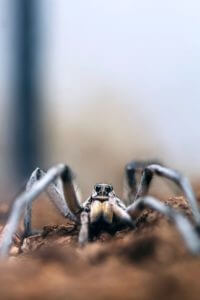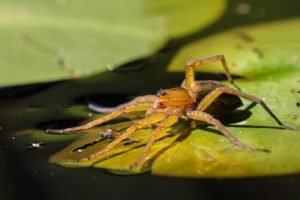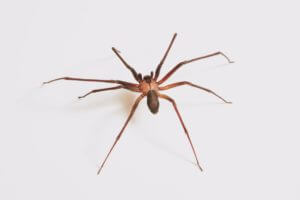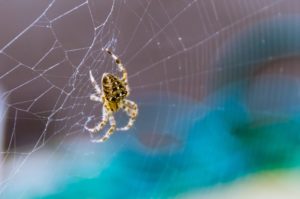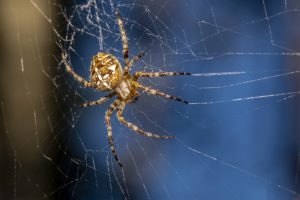What Does a Spider Look Like?
A spider’s body has two segments. One part includes the head, three to four pairs of eyes, a mouth, and eight legs. The second, larger half is their abdomen, where they can produce a silk webbing they use to catch prey, travel, or hold eggs. Some of the most common spiders in New England include:
- Wolf Spiders: Wolf spiders are dark brown spiders that are active hunters. They hide during the daytime and come out at night in search of food. You might see them chasing prey or running along walls or across floors.
- Fishing Spiders: This spider lives close to rivers, lakes, and streams in wooded areas of New England. They are gray with black or light brown markings and look similar to a wolf spider but smaller.
- Jumping Spiders: Depending on the species, this tiny spider can be dark-colored or bright and iridescent. These pests have short legs and stout, hairy bodies. Jumping spiders often hide under rocks or in debris and may leap when startled.
- Orb Weavers: A common garden spider, orb weavers can be black and yellow or black and red. They spin large webs in tall weeds or brush and usually hang in the middle of the web with their heads pointed downward.
- Longbodied Cellar Spiders: Also called daddy long-legs, the cellar spider is one of the most common species in New England. They have pale tan or yellow and gray bodies with long, thin legs. The cellar spider typically lives in protected areas like basements, warehouses, and garages.
How Big Are Spiders?
The size of a spider depends on the age and species. Considered small, the jumping spider can grow as big as your fingernail. On the other hand, a wolf spider averages over one inch. Many female spiders grow much larger than males. Keep in mind that the size of a spider does not determine how dangerous their bite may be.
Are Spiders Dangerous?
Although all spiders have venom glands, they usually only bite people in self-defense. If trapped inside your clothing or handled carelessly, these pests might bite to protect themselves. There are a few especially dangerous species, including:
- Brown Recluse: A brown recluse is tan with a dark brown, violin-shaped mark on its back. You may not feel a brown recluse bite, but the affected area can develop tissue damage and painful sores that heal slowly. These pests are not very common in New England.
- Black Widow: The black widow has highly toxic venom that causes severe pain and muscle cramps. This spider has a shiny, black body with a distinctive red or reddish-orange hourglass pattern.
- Yellow Sac Spider: Several species of sac spiders live indoors. The yellow sac spider has a light yellow or cream-colored body. It can be aggressive toward people, and their bite causes a burning sensation and intense itching.
Spider Photo Gallery
Spiders can be beneficial. They help control insect populations, and most types aren’t dangerous to humans or pets. However, some people have an extreme fear of spiders, which can cause restaurant patrons or retail customers to leave. By looking through these photos of spiders, you can identify what type you have in your home or business. Knowing the type of spider helps to treat for them.
Spiders live primarily outdoors, like in this picture of a spider outside. They might seek food, shelter, or warmth inside the home.
Cellar Spiders
This photo of a cellar spider shows the pest’s extremely long legs and small, round body.
Cellar spiders cling to their webs in protected areas such as undisturbed corners and garages or basements.
As the most common house spider in the United States, cellar spiders can develop in large populations. Usually, you find them indoors near sources of warmth. A cellar spider is not harmful in any known way, but the pest’s large size and extremely long legs can appear frightening.
This is a picture of young spiders that recently hatched. They are smaller than adults, but hatch in groups of several hundred.
Black Widow Spiders
This photo of a black widow spider reveals a distinctive red hourglass patch on its abdomen.
Here is another image of a black widow spider in which you can see the red marking.
These two pictures of black widow spiders show their robust, black color and the red shape on the abdomen. This is the easiest way to identify a black widow spider. Despite their dangerous and painful bite, black widows are timid and do not readily bite unless handled carelessly. They build webs in dark corners and other secluded areas. Black widow spiders prefer to be outdoors but can sometimes make it inside looking for warmth or if they are brought in accidentally.
Jumping Spiders
This is a closeup photo of a brightly colored jumping spider.
Adult jumping spiders only grow to about the size of a thumbtack. However, these tiny spiders can jump about twenty times their body length when they feel threatened. Their small, stout bodies and sprightly legs also make it easy for them to move quickly across short distances.
Wolf Spider vs. Fishing Spider
A large and hairy species, wolf spiders mainly live outdoors and hunt at night.
In this closeup image of a wolf spider, you can see the spider’s large fangs which give them a strong bite for hunting.
This picture of a fishing spider on water establishes the species’ typical habitat.
These three photos of a wolf spider and a fishing spider show a clear difference between the species. Although they often look alike because of their large size and hairy bodies, the two pests live in different habitats. Wolf spiders hunt on the ground, while you can identify a fishing spider by the way it hunts on or nearby water.
Brown Recluse Spider
This photo of a brown recluse reveals the dark, violin-shape marking on the spider’s back.
Brown recluse spiders are rare in New England, but their bite is still dangerous. Fortunately, this species actively avoids being around people. The pest hides their webs in dark, quiet places and is only active at night. In addition to the distinct violin-shaped mark on their back, brown recluse spiders are unique because they only have six eyes whereas other spiders have eight.
Orb Weaving Spiders
Orb weavers are brightly colored and typically rest on their webs like in this photo of a yellow orb weaver.
Spiders spin silk to build and fix their webs which you can see in this picture of an orb weaver repairing its web.
Orb weaving spiders are typical garden spiders. These pests have colorful markings and build their webs in tall weeds, foliage, and bushes in sunny areas. Orb weavers feed on insects in your backyard and they don’t often bite people unless you handle a female with an egg sac in her web.
Yellow Sac Spider
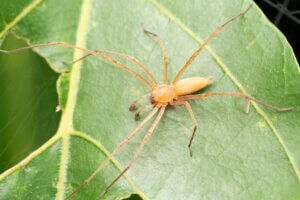
This photo of a male yellow sac spider on a leaf shows the pest’s semi-clear, yellowish color.
The yellow sac spider is the most common culprit of spider bites in the house. You can find these pests all over the home such as corners of the wall or under floorboards. Because they are nocturnal, the sac spider hides during the day. They spin silken tubes called retreats that blend in with neutral or light-colored walls, making them difficult to notice.
